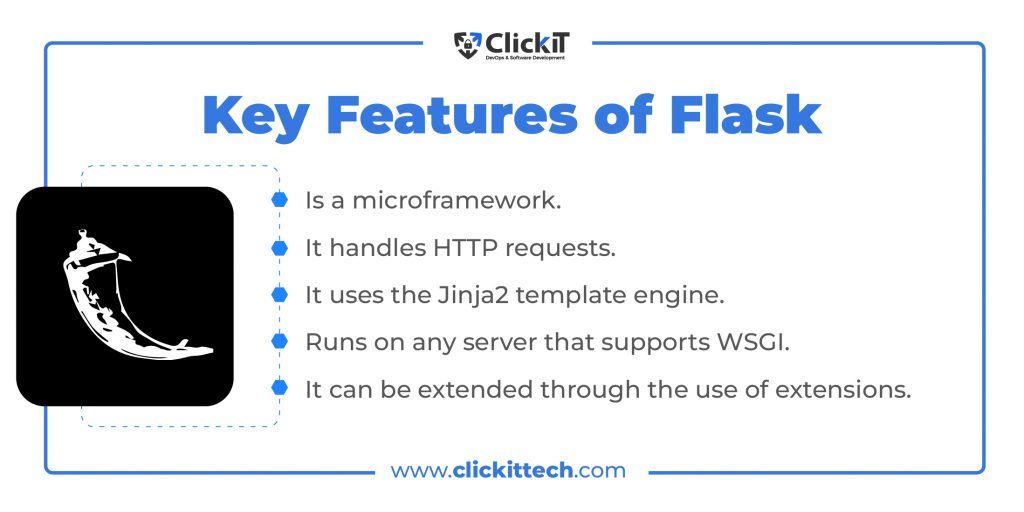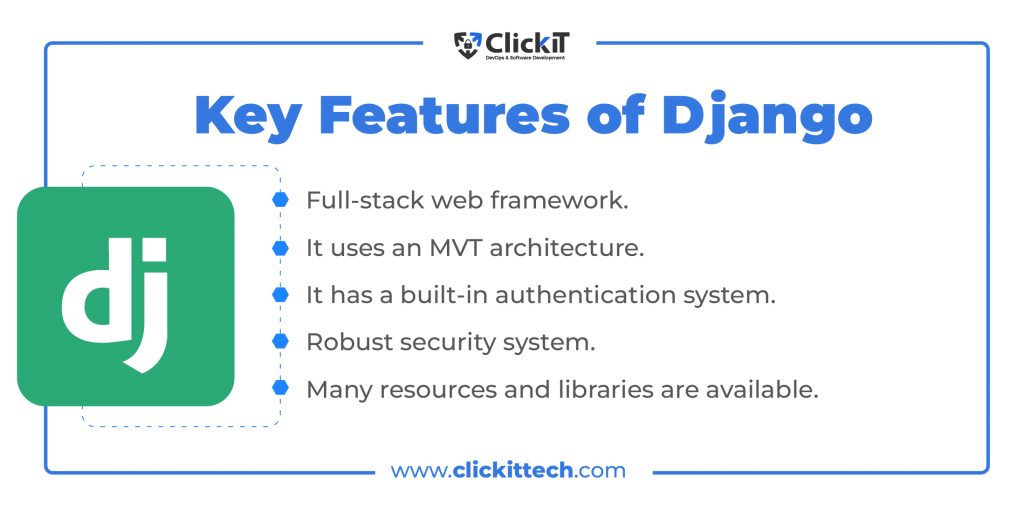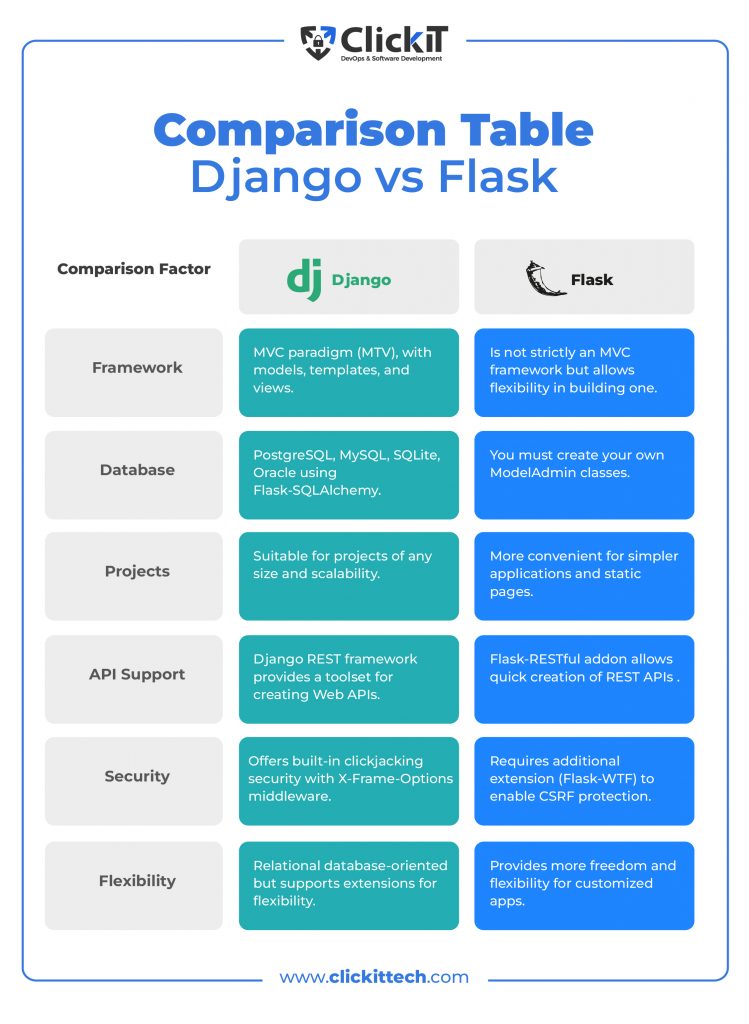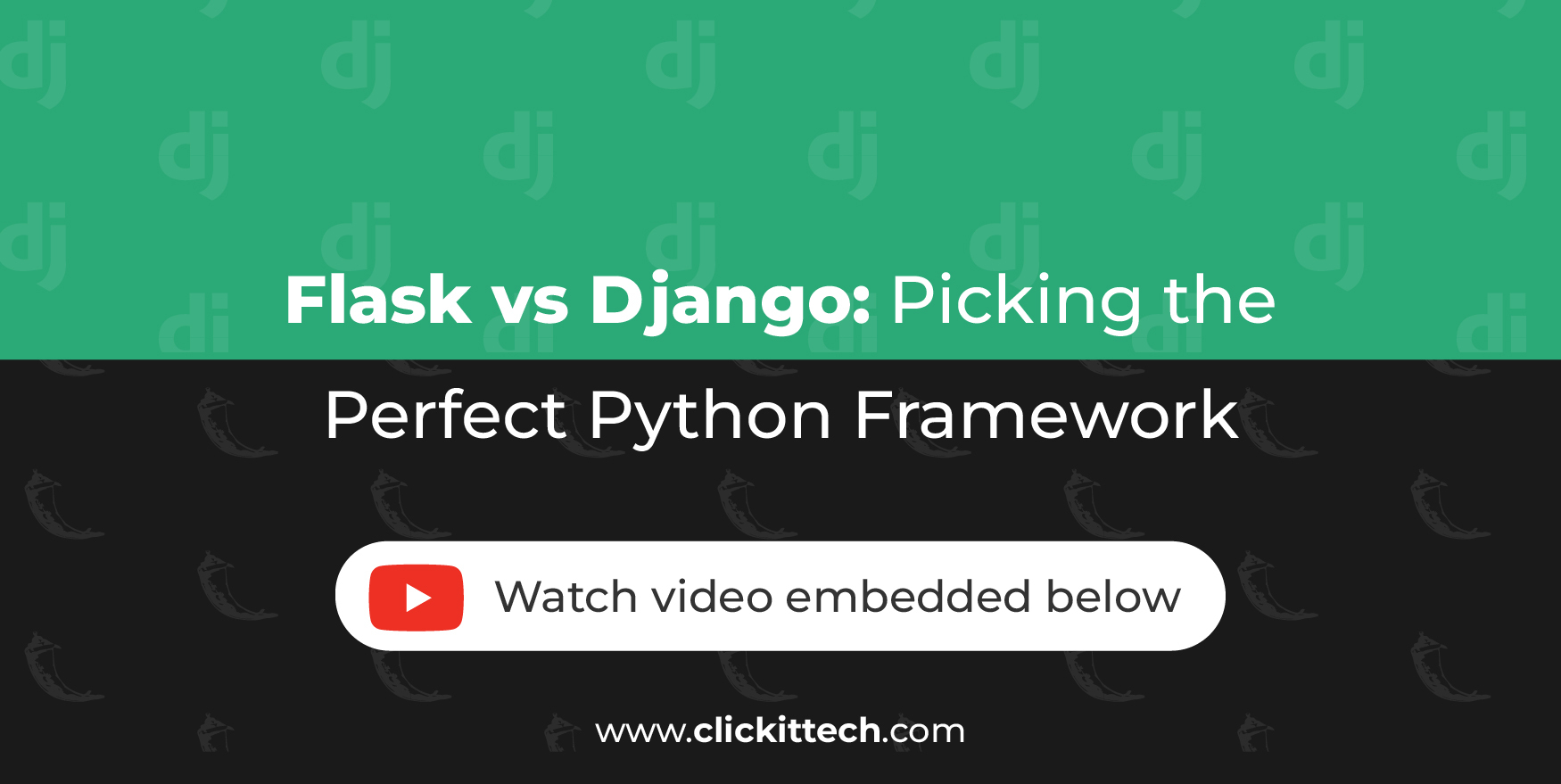Flask vs Django is a debate in the Python world since it is a popular and powerful programming language with a wide use for various purposes. Said purposes include web development, data science, scientific computing, and scripting.
Python provides several frameworks that make it easy to build, deploy, and maintain web applications. Furthermore, two of the most popular and widely-used Python web frameworks are Django and Flask.
To enter the debate of Python Flask vs Django, let’s dive into everything you need to know to choose between Flask or Django.
Table of contents
- Flask vs Django Video
- Introduction to Flask
- Which Companies Use Flask?
- Introduction to Django
- Which Companies Use Django?
- Django vs Flask Comparison
- Django vs Flask: Which one to choose?
- Conclusion
- FAQs
Flask vs Django Video
Introduction to Flask
Flask is a Python Web framework for building various types of web applications easily. It’s an unopinionated web framework, which means it does not enforce a particular directory structure or code organization scheme.
This allows developers to use their preferred tools and techniques and tailor their applications to their specific needs. Flask uses the Jinja2 template engine to render HTML templates, providing support for several popular databases through third-party libraries.
Flask includes several out-of-the-box security features. These include support for secure cookies and the ability to protect against common web attacks. It also includes a built-in development server and debugger, which makes it easy to test and debug applications during development.
Flask has a large and supportive community of users and contributors who provide support and contribute to the framework’s development. This community ensures that Flask remains up-to-date, relevant and that users can access a wealth of resources and support.
Overall, Flask is a versatile and powerful microframework well-suited for developing small, focused web applications. Its simple design and excellent documentation make it easy to learn and use. Meanwhile, its modular structure and support for popular databases and template engines make it great for scalable, maintainable applications.
Key Features of Flask

- Flask is a micro web framework written in Python that provides the basic tools for building web applications. It is classified as a microframework because it does not include an ORM (Object Relational Mapper) or such features. It also relies on external libraries for database connectivity and such.
- Flask allows developers to handle HTTP requests (GET, POST, PUT, DELETE, etc.) and route URLs to specific functions in code. Decorators are special functions that modify the behavior of other functions and help achieve this.
- Flask uses the Jinja2 template engine, which allows developers to create dynamic HTML, XML, or other markup. Passing variables and expressions from the Python code to the template allows rendering and returning it to the client.
- Flask supports the use of WSGI (Web Server Gateway Interface) compliant HTTP servers for running web applications. This means that Flask applications run on any server that supports WSGI, such as Gunicorn or uWSGI.
- Flask can go through the use of extensions, which are third-party packages that add additional functionality to the framework. Examples of Flask extensions include support for ORMs, form validation, and authentication.
Advantages of Flask
Lightweight and easy to learn: It is a good choice for developers who are new to web development or Python. It has a minimalistic design and provides only the essential features for building web applications. This makes it easier to understand and work with.
Flexible: Allows developers to have full control over their applications, simplifying the customization and building of what they want. Flask does not force any particular directory structure or require the use of specific libraries. Hence, developers are free to structure their code in the way that makes the most sense for their project.
Good documentation: A large and active community, so developers can easily find answers to their questions. The Flask documentation is well-written and easy to follow. Also, there are many online resources and tutorials available for learning Flask.
Compatibility: Compatible with a variety of databases and front-end frameworks. This way, developers can use the tools they are most comfortable with. Flask works with any database that has a Python driver and integrates with front-end frameworks like Bootstrap or jQuery.
Suitable for small to medium-sized projects: It can scale easily as the project grows. Consequently, making it a good choice for startups and other small businesses. Its setup is easy to start with, and its deployment to production can require minimal effort. As the project grows and the requirements become more complex, Flask can extend with additional libraries and frameworks as needed.
Disadvantages of Flask
Limited features: Because Flask is a microframework, it provides only the basic components necessary for web development. It doesn’t include the extra features and tools included in more comprehensive frameworks. This means that developers may need to use third-party libraries to add additional functionality to their applications.
Lack of database abstraction layer: Flask does not include a database abstraction layer. Therefore, developers must choose and manage their database engine and connection libraries. This can be more difficult for inexperienced developers who are not familiar with databases.
Larger learning curve: Because Flask is a microframework, it can have a steeper learning curve than more comprehensive frameworks. Developers may need to spend more time learning how to use Flask and its various components and may need to use third-party libraries to add additional functionality.
Limited scalability: Flask’s design makes it lightweight and scalable, but it may not be as scalable as some other frameworks. This may be an issue for developers who are building large, complex applications that require a high degree of scalability.
Which Companies Use Flask?
The Flask framework has frequent use in backend web development on websites. These websites include social media platforms, internet shops, and institutions of higher learning.
Businesses, including Red Hat, Rackspace, Airbnb, Airflow, Netflix, PythonAnywhere, Lyft, Pinterest, Reddit, and Rackspace. For instance, Pinterest is a social media platform that makes use of pinboards to share images and links. It offers its customers access to a vast database of photos, GIFS, and videos thanks to the use of Flask as its main web framework.
Read our blog on How to dockerize a Flask Python Application
To continue the big Python debate of Flask vs Django, let’s dive into everything you need to know about Django.
Introduction to Django
Django is a free and open-source web framework written in Python. It is a full-stack framework, which means it provides all the components necessary for developing web applications, including a database connection layer, an object-relational mapper (ORM), a templating engine, and a server-side scripting environment.
One of the primary goals of Django is to allow developers to convert their ideas into web applications as quickly as possible. Its pragmatic, opinionated design emphasizes reusability and modularity, and it includes several powerful features that make it easy to build complex database-driven web applications.
One of the key features of Django is its powerful ORM, which allows developers to interact with databases using simple, Pythonic code. This eliminates the need to write SQL queries by hand and makes it easy to create, read, update, and delete database records. Django also includes a built-in admin interface, which allows developers to manage their application’s content easily and efficiently.
Django has a robust security system that helps protect against common web attacks, such as cross-site scripting (XSS) and SQL injection. It also includes built-in support for user authentication and authorization, which makes it easy to implement user login and access control in web applications.
Django has excellent documentation and a large, supportive community of users and contributors. This community provides support and contributes to the framework’s development, ensuring that Django remains up-to-date and relevant.
Overall, Django is a versatile and powerful web framework, well-suited for developing complex, database-driven web applications. Its emphasis on reusability and modularity makes it easy to build large, scalable applications with a clean, maintainable codebase.
Key Features of Django

- Django is a high-level, full-stack web framework written in Python that provides a complete set of tools for building web applications. It includes an ORM (Object Relational Mapper) for interacting with databases, a templating engine for generating HTML or other markups, and a variety of other utilities for handling common web development tasks.
- Django uses a Model-View-Template (MVT) architecture, which separates the data model, the user interface, and the business logic of the application. This makes it easier to design and maintain complex web applications.
- Django has a built-in authentication system that handles user accounts, permissions, and groups. It also supports the use of third-party authentication backends such as LDAP or OAuth.
- Django has a robust security system that protects against common vulnerabilities such as cross-site scripting (XSS), cross-site request forgery (CSRF), and SQL injection. It also supports the use of SSL/TLS for secure communication.
- Django has a large and active community, with a wealth of resources and libraries available for extending its functionality.
Advantages of Django?
Full-featured : Provides a complete set of tools for building web applications, making it a good choice for developers who need to build complex and feature-rich applications.
MVT architecture: Makes it easier to design and maintain complex web applications, as it separates the different aspects of the application into distinct layers.
Built-in authentication system: Support for third-party authentication backends makes it easy to handle user accounts and permissions.
Robust security system: Protects against common vulnerabilities and allows developers to build secure applications with minimal effort.
Large and active community: A wealth of resources and libraries available for extending its functionality. This means that developers can find solutions to common problems and add new features to their applications with ease.

Disadvantages of Django
Steep learning curve: Because Django is a full-stack framework, it can have a steep learning curve for developers who are new to web development or who are not familiar with all of the components and features that it provides.
Opinionated design: Django’s design is opinionated, which means it enforces a particular directory structure and code organization scheme. This can make it difficult for developers who are used to working in different ways, or who have existing code that does not conform to Django’s conventions.
Monolithic structure: Django’s monolithic structure means that all of its components are tightly integrated and dependent on each other. This can make it difficult to replace or modify individual components and can make it challenging to scale or extend applications in certain ways.
Limited flexibility: Because Django is a full-stack framework, it includes several predefined components and features. While this can make it easy to develop certain types of applications, it can also limit flexibility and make it difficult to customize applications to meet specific needs.
Which Companies Use Django?
About 2563 businesses, including National Geographic, Mozilla, Spotify, Instagram, and Udemy, are said to employ Django in their software stacks. Instagram is one of the social networking platforms for sharing images and videos. The app also uses Django in the largest deployment ever.
Python is a top pick for Instagram due to its usefulness and simplicity. But as the platform grew, effectiveness grew in importance. Instagram Engineering was able to create unique tools to achieve this objective using Django.
Django vs Flask Comparison
Django and Flask are both popular web frameworks for Python, and both frameworks have their strengths and weaknesses. Here is a comparison of Python Flask vs Django frameworks on various factors:

Flask vs Django: Type of Framework
Between Flask vs Django Python framework Flask doesn’t really handle the model layer, so it isn’t an MVC framework, but it does not impose any limitations on you if you choose to build one. Flask will readily assist you if you require a straightforward, single-file online application that accepts a form and returns a response, whether in HTML or not.
Although it utilizes slightly different terminology, Django closely adheres to the MVC paradigm. Django is an MTV (Model-Template-View) framework in its most basic form. Django refers to Views and Controllers as Views. In Django, views are referred to as templates, and controllers as views.
Flask vs Django: Database
Multiple databases such as PostgreSQL, MySQL, SQLite, and Oracle, are supported since Flask-SQLAlchemy (using SQLA class framework) can be used. The framework’s security tables would be built at the default connection, SQLALCHEMY_DATABASE_URL.
Django’s admin does not explicitly support multiple databases. You must create your own ModelAdmin classes that instruct the admin to utilize a certain database for content if you wish to offer an admin panel for a model on a database different than the one given by your router chain.
Read our blog PostgreSQL vs MySQL
Flask vs Django: Type of Projects
Between Flask vs Django python framework, for simpler applications, Flask is more convenient to use. Flask will be more convenient for you than Django if you’re trying to create a web project that is largely straightforward and has a few static pages.
Every kind of web application may be built using the Django platform. Whether you need a tiny application or have a huge project in mind, this framework may be the best option for you. It also enables the development of scalable applications. However, some individuals say that despite the fact that you can practice Django for newbie projects for educational purposes, it is too sophisticated to be used for simple apps. Django would be a redundant addition to your technological stack if your app doesn’t require a backend development.
Flask vs Django: Template Engine
Flask uses Jinja2 as its template engine. Naturally, you are welcome to use an alternative template engine, but in order to run Flask, you still need to install Jinja2. To make rich expansions possible, this condition must be met. Jinja2’s presence may be necessary for an extension.
The template system used by Django is called the Django template language. It was the built-in option accessible up until Django 1.8. Despite being rather opinionated and having a few quirks, it’s a useful template library. The Django template engine offers a potent mini-language for specifying the user-facing layer of your program, encouraging a clear separation of implementation and presentation logic. Anyone with a working grasp of HTML can maintain templates; Python is not necessary.
Flask vs Django: API support
A Flask addon called Flask-RESTful makes it possible to create REST APIs quickly. It is a simple abstraction that integrates with your current ORM and libraries. Best practices are promoted with minimal setup with Flask-RESTful. If you are already familiar with Flask, learning Flask-RESTful should be simple.
For creating Web APIs, the Django REST framework (DRF) offers a potent and adaptable toolset. Its biggest advantage is how much simpler serialization is as a result.
If you are familiar with Django, the Django REST framework is a great choice because it is built on the class-based views of Django. It incorporates implementations for model validator, forms, class-based views, QuerySet, and other things.
Flask vs Django: Security
The Flask framework does not have CSRF protection by default, but we may add it by using the Flask-WTF extension. Here is an illustration of how to enable CSRF protection. It will allow CSRF protection for the entire app, protecting us against CSRF.
The X-Frame-Options middleware, which in a compatible browser can restrict a site from becoming rendered inside a frame, is a feature of Django’s clickjacking security. It is possible to modify the precise header value transmitted or to deactivate the security on a per-view basis.
Flask vs Django: Flexibility
Between Python Flask vs Django, Flask allows programmers the freedom to alter their apps however they see fit. This enables them to lessen problems that can occur as a result of other frameworks’ rigidity. They are released from having to use particular technical elements.
The Django web application framework only functions well with relational databases, it is vital to know. Flask provides a variety of extensions that integrate with the Marshmallow framework-independent library. As a result, it can offer greater flexibility than Django.
Partner with the best! Choose our ClickIT’s LATAM engineers for Flask and Django projects. Contact us.
Django vs Flask: Which one to choose?
So now the final question, Flask vs Django, which one should I choose? Developers who are building large, complex, database-driven applications may prefer Django, while developers who are building small, focused applications or who are new to web development may prefer Flask.
The choice between Django vs Flask will depend on the specific needs and goals of the project. Both frameworks have their advantages and disadvantages, and the right choice will depend on the type of application being developed and the developer’s experience and preferences.
Django is a full-stack framework that provides all the components necessary for developing web applications, including a database connection layer, an ORM, a templating engine, and a server-side scripting environment. This makes it easy to build complex, database-driven applications without having to integrate and manage multiple tools and libraries.
Django’s robust and opinionated design emphasizes reusability and modularity and includes several powerful features that make it easy to build large, scalable applications. However, Django has a steep learning curve, and its opinionated design can make it difficult to customize or modify individual components.
On the other hand…
Flask is a microframework that provides only the core components needed for web development without the extra features and complexity of more comprehensive frameworks. This makes it easy to learn and use, and well-suited for developing small, focused applications.
Flask is un-opinionated and flexible and allows developers to use their preferred tools and techniques. However, Flask’s limited feature set means that developers may need to use third-party libraries to add additional functionality to their applications, and its lack of a database abstraction layer can make it more difficult to work with databases.
Overall, the best choice between Python Django vs Flask will depend on the specific needs and goals of the project. It is also worth considering the developer’s experience and preferences, as well as the availability of support and resources for each framework.
Read our blog on How to hire a Python developer.
Conclusion of Flask vs Django
So, between Flask vs Django, with Flask, you may start learning about frameworks, but Django would let you advance your skills in complex tools and programming. Any web developer needs to possess both of these abilities. When applying for jobs, having a solid understanding of Python Flask vs Django might put you ahead of the competition.
You can choose what is best suited for you, between Python Flask vs Django, but be an expert at it because they are in high demand and crucial to the web development industry.

FAQs
If you want to build a straightforward web application with a couple of static pages, Flask will be more convenient than Django. For smaller web applications, many developers find Flask to be easy to scale.
If you’re utilizing a relational database, Django should be your first choice for a framework. If your project calls for the use of a non-relational database, Flask may be a better option. Through a request, mapping of URLs to views & support functions is permitted.
Since the code for Flask web applications is typically clearer than that of Django, it is thought of as being more “Pythonic” than Django. The majority of newbies choose Flask since it requires barriers to getting a simple app to function properly.
Many companies use both Django and Flask for web development.
Ultimately, the choice between Django and Flask depends on the specific project requirements, team preferences, and the desired level of complexity.
Use Django when you need a comprehensive, all-in-one framework with built-in features for larger projects. Choose Flask for more flexibility and customization in smaller projects where a lightweight approach is preferred.
Learning either Django or Flask can be beneficial for job opportunities, but the choice depends on the types of roles and projects you’re interested in. Research job descriptions and consider your preferred development style to make an informed decision








